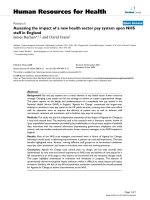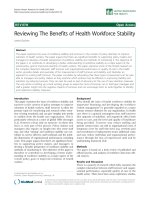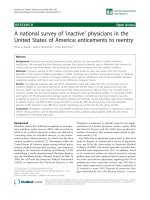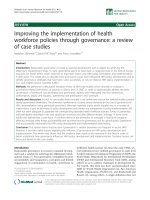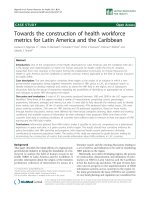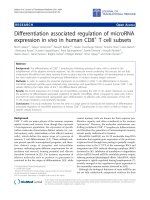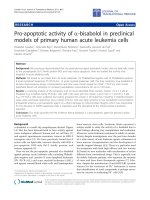báo cáo sinh học:" Doubling the number of health graduates in Zambia: estimating feasibility and costs" pdf
Bạn đang xem bản rút gọn của tài liệu. Xem và tải ngay bản đầy đủ của tài liệu tại đây (814.35 KB, 9 trang )
RESEARC H Open Access
Doubling the number of health graduates in
Zambia: estimating feasibility and costs
Aaron Tjoa
1*
, Margaret Kapihya
2
, Miriam Libetwa
2
, Joanne Lee
3
, Charmaine Pattinson
3
, Elizabeth McCarthy
1
,
Kate Schroder
1
Abstract
Background: The Ministry of Health (MoH) in Zambia is operating with fewer than half of the human resources for
health (HRH) necessary to meet basic population health needs. Responding urgently to address this HRH crisis, the
MoH plans to double the annual number of health training graduates in the next five years to increase the supply
of health workers. The feasibility and costs of achieving this initiative, however, are unclear.
Methods: We determined the feasibility and costs of doubling training institution output throu gh an individu al
school assessment framework. Assessment teams, comprised of four staff from the MoH and Clinton Health Access
Initiative, visited all of Zambia’s 39 public and private health training institutions from 17 April to 19 June 2008.
Teams consulted with faculty and managers at each training institution to determine if student enrollment could
double within five years; an operational planning exercise carried out with school staff determined the investments
and additional operating costs necessary to achieve expansion. Cost assumptions were developed using historical
cost data.
Results: The individual school assessments affirmed the MoH’s ability to double the graduate output of Zambia’s
public health training institutions. Lack of infrastructure was determined as a key bottleneck in achieving this
increase while meeting national training quality standards. A total investment of US$ 58.8 million is required to
meet expansion infrastructure needs, with US$ 35.0 million (59.5%) allocated to expanding student accommodation
and US$ 23.8 million (40.5%) allocated to expanding teaching, studying, office, and dining space. The national
number of teaching staff must increase by 363 (111% increase) over the next five years. The additional recurring
costs, which include salaries for additional teachers and operating expenses for new students, are estimated at US$
58.0 million over the five-year scale-up period. Total cost of expansion is estimated at US$ 116.8 million over five
years.
Conclusions: Historic underinvestment in training institutions has crippled Zambia’s ability to meet expansion
ambitions. There must be significant investments in infrastructure and faculty to meet quality standards while
expanding training enrollment. Bottom-up planning can be used to translate national targets into costed
implementation plans for expansion at each school.
Background
Many resource-limited countries are facing the challenge
of too few health workers to care for their population.
Not enough doctors, nurses, clinical officers, midwives,
medical assistants, and other key healthcare cadres are
produced from training institutions to staff the health
workforce [1-5]. Critical staffing shortages prevent these
countries from delivering basic health services and
meeting their health-related Millennium Development
Goals [1,6-9].
In 2005, th e Government of the Republic of Zambia
Ministry of Health (MoH) e stimated that it ha d fewer
than half of the health staff necessary to deliver basic
health services across the country, with even more acute
shortages at rural clinics [10,11]. The Ministry of Health
National Health Strategic Plan 2006 to 2010 provided
several strategies to increase the size of the health
workforce through the improvement of training,
* Correspondence:
1
Clinton Health Access Initiative, Boston, USA
Full list of author information is available at the end of the article
Tjoa et al. Human Resources for Health 2010, 8:22
/>© 2010 Tjoa et al; licensee BioMed Central Ltd. This is an Open Access article distributed under the terms of the Creative Commons
Attribution License ( which permits unrestricted use, distribution, and reproductio n in
any medium, provided the original work is properly ci ted.
management, and retention; how these strategies could
be implemented or which combination of strategies
could increase the health workforce size enough to
reach staffing targets was not determined [10]. An ana-
lysis of these strategies in late 2007 found that staffing
targets would never be met without a significant
increase in health training institution graduates [5]. In
response, the Ministry of Health National Training Plan
2008 provided top-down targets for doubling the num-
ber of graduates during a five year period.
This study is based on the operational planning process
commissioned by the National Training Plan 2008 to
analyze how to double health training institution gradu-
ates in the next five years while meeting national training
quality standards. We usedabottom-upapproachto
assess the costs and feasibility of doubling graduates at
each of the 39 public and private health training institu-
tions in Zambia, which run a total of 72 health degree,
diploma, and certificate programs [12]. The operational
planning process was led by the MoH, with the Clinton
Health Access Initiative providing technical support in
assessment design, implementation and analysis. The
assessment’ s structure, object ives and methodology
underwent a MoH approval process carried out by the
Human Resources Task Group on Training, a committee
chaired by the MoH Directorate of Human Resources
and Administration and comprised of other government
and partner stakeholders. Progress updates and the final
report were then presented to the Human Resources
Technical Working Group, whose approval of the final
draft resulted in the dissemination of the National Train-
ing Operational Plan report and formal MoH adoption of
the assessment’s training institution-speci fic enrollment
and infrastructure scale-up targets.
Methods
Data collection
Members of staff in each training instituti on were inter-
viewed to determine the feasibility and costs of expan-
sion using a standardized field questionnaire. The
questionnaire followed a semi-structured interview for-
mat. Training institution staff members were asked to
report on what scale-up student enrollment targets were
feasible and were then led through an operational plan-
ning process to determine the key actions and invest-
ments necessary to accomplish these targets and the
ass ociated timeframe. These key actions included hiring
faculty, building infrastructure, and procuring training
materials. All associated one-time investments and addi-
tional annual recurring costs were mapped out for the
next five years. A database was built using Access
(Office, Microsoft; 2007) to collect and track responses
to the training institution interview questions during the
administration of the questionnaire.
Starting on 17 April 2008, two field teams carried out
a three week pilot of the assessment. Each assessment
team was comprised of a total of four individuals from
the MoH Directorates of Human Resources and Plan-
ning and the Clinton Health Access Initiative. During
this period, the teams assessed five training institutions
that in total offered eleven health training programs.
The schools were chosen for their variety of programs,
public and private management, regional diversity, and
size. After the pilot phase, the remaining 34 training
institutions were assessed over the subsequent two
months until 19 June 2008.
Costing information for all aspects of expansion was
collected from the Ministry of Health Directorate o f
Planning and Development, which oversees funding of
most public health training institutions, and from
schools that recently completed construction projects.
Discussions were held with the Ministry of Works and
Supply to evaluate the construction tendering process
and to propose a shortened tendering process for train-
ing institution infrastructure scale-up. Assumptions for
teaching staff salaries and housing allowances for tea-
chers were obtained from the Public Service Manage-
ment Division. Per-student costs, which encompass all
non-faculty school maintenance and operational costs,
were collected from schools. A stable 3500 Zambia kwa-
cha to one United States dollar (US$) exchange rate was
assumed.
Analysis
A model in Excel (Office, Microsoft; 2007) was devel-
oped to project the infrastructure and faculty needs f or
training institutions with three degree program s or less,
which covered over 90% of all schools in Zambia.
Faculty needs were broken down by the need for both
tutors, who provide the didactic lectures in the schools,
and clinical teachers, who provide hands-on instruction
during skills labs and at practicum sites. The model
determined the minimum number of faculty needed at a
school by dividing the weekly classroom, laboratory and
practicum hourly requirements for each semester of
each program by the set number of hours that a tutor
lectures in a week. The weekly classroom, laboratory
and practicum hourly requirements were collected from
the professional regulatory bodies, which mandate the
curriculum that each school must provide, and refined
based on input from training schools. The set number
of hours a tutor c an lecture in a week was dete rmined
during assessments and later validated by the quality
standards set by professional regulatory bodies. To cal-
culate infrastructure needs, the expected annual s ize of
the student body at each training institution was multi-
plied by national student-to-training-infrastructure stan-
dard quality ratios.
Tjoa et al. Human Resources for Health 2010, 8:22
/>Page 2 of 9
The Chainama College of Health Sciences, Evelyn
Hone College, and University of Zambia’ s School of
Medicine, which offer more than seven health training
programs each, had to be assessed without the Excel
model due to the unique complexity of the operations
at each school. The assessment determined resource
needs through several consultations with ea ch school’s
management and training program heads.
An Excel-based calculating tool converted the indivi-
dual school scale-up needs into one-time and additional
annual recurring costs. Standard cost assumptions were
used for all health training institutions.
Quality standards consensus
A National Quality Standards Consensus workshop was
convened for the first time to set national minimum
infrastructure quality standards for health training insti-
tutions. Participants included professional regulatory
bodies, training experts, MoH policy officers, and training
institution administrators. The workshop set minimum
quality standard ratios such as the maximum number of
students per dormitory room, classroom, skills-lab, prac-
ticum site, library, computer lab, and dining hall, in addi-
tion to the maximum number of faculty per staff office
and house [13]. The national quality standard ratios for
the number of students per tutor and clinical teacher
were also reviewed. This provided the quality ratios used
to analyze resource needs in this analysis.
Operational plans
School-specific operational plans were produced after
the analysis and sent to each training institution for
final review (see Fig. 1). The plans detailed each school’s
annual student targets and the year in which the targets
woul d be completed. The key, prioritized actions neces-
sary to accomplish these targets were listed along with
target dates of completion. All associated one-time and
additional recurring scale-up costs were detailed from
2008 to 2012. Lastly, the plans provided a description of
the current student capacity.
Figure 1 Example school-specific one-page operational scale-up plan. The study produced one-page summary plans that contained each
school’s annual student intake targets and the year in which the targets would be achieved. The key, prioritized actions necessary to accomplish
these targets are listed along with target dates of completion. All associated one-time and additional recurring scale-up costs are detailed for
five years. Lastly, the plans provide a description of current student capacity. The compilation of each school’s one-page operational plan
provided a national blueprint for the resources and activities needed to reach the National Training Plan targets.
Tjoa et al. Human Resources for Health 2010, 8:22
/>Page 3 of 9
Results
Publically operated schools
The individual school assessments determined that
Zambia could increase aggregate annual health training
enrollment at the 30 publically run schools by up to
94% over five years with sufficient financial support.
This represents an aggregate increase in annual student
intake at these schools from 1897 students in 2007 to
3675 students in 2012 (Table 1).
School administrators reported having a large enough
pool of applicants to meet scale-up student intake tar-
gets without a loss in the quality of trainees. The annual
applicant pools were described as having two to three
times the number of qualified applicants as there were
available slots for t raining. Qualified applicants were
defined by administrators as applicants who had suc-
cessfully completed the requisite basic certificate or
diploma for each training program. Previously, schools
preferred to accept candidates applying from their
immediate geographical area to minimize the risk of
attrition during the program. Dropout is low at most
training schools (< 5%), with family issues or pregnancy
as the leading cause of dropout. In increasing the size of
their intakes, training institutions anticipated having to
accept candidates from regions further from their
school, which would present the risk of increasing the
number of students that dropout because they have to
return home for family reasons.
The expansion of publically run schools is estimated
to cost US$ 116.8 million over five years. US$ 58.8 mil-
lion of this total is needed for one-time infrastructure
and furnishing costs, while US$ 58.0 million is needed
for additional annual recurring costs. The additional
annual recurring costs include expenditures for addi-
tional students (including food, training materials, and
all non-faculty school maintenance and operational
costs), faculty housing allowances, and new faculty sal-
aries. The majority of the additional recurring costs are
accounted for by the US$ 40.6 million (70.1%) needed
for additional stu dent costs (see Tabl e 2). Facul ty hous-
ing allowances, which total US$ 8.2 m illion across the
five years, were provided in many cases instead of build-
ing faculty houses, since housing allowances were deter-
mined to be more cost-effective, with annual housing
allowances costing only 8% of the cost of building a new
house.
One-time investments in infrastructure are required
both to expand capacity and to address immediate qual-
ity concerns. Nearly 70% of pu blically run schools were
operating below recommended national infrastructure
standards, resulting in overcrowding and reduced train-
ing quality. Nationally, student accommodation, staff
office space, teacher accommodation, and librar y seating
capacity must increase by over 150% from their current
levels to ensure that training conditions meet recom-
mended quality standards during scale-up (see Table 3).
For expansion to succeed, the number of tutors and
clinical teachers must increase by 363 (111%). Broken
down by teacher type, the aggregate number of tutors
must increase from the current level of 260 to 431 (66%
increase) in 2012 post scale-up. The need for clinical
skills teachers was neither fully considered nor funded
in the past, and to reach quality standards during scale-
up, the aggregate number of clinical teachers must
increase remarkably from 66 to 258 (291% increase).
Our costing of the expansion activities found that the
most expensive one-time cost category is building, reno-
vating, and furnishing student accommodation. This
activity is est imated to cost US$ 35.0 million (59.5% of
tot al one-time costs) across the 30 public training insti-
tutions (see Table 4). The remaining US$ 23.8 million
(40.5% of total one-time costs) is spent on new staff
offices, new staff accommodation (mostly in rural areas
where renting is not feasible), new kitchen and dining
hall facilities, new and refurbished classrooms and lec-
ture theatres, new and refurbished libraries and books,
and new chemical, biomedical, and skills laboratories.
Discussions with the Ministry of Works and Supply
revealed that the time to commence a construction pro-
cess during training institution expansion may be longer
than the normal three to six month tendering process
due to a current backlog of work and staff capacity
Table 1 National Training Plan 2008: current and target
level of training output by cadre at public training
institutions, Zambia
Cadre Annual training institution output
2007
Output
2012 Output, Post
Scale-up
Medical doctor 67 150
Nurse 900 1,636
Midwife 300 765
Medical licentiate 20 20
Clinical officer 133 190
Post basic nurse
(teaching staff)
35 50
Laboratory staff 120 264
Pharmaceutical staff 120 150
Environmental health staff 96 240
Radiography staff 40 80
Paramedical staff 66 130
Total 1897 3675
The individual school assessments determined that Zambia could increase
aggregate annual health training enrollment at the 30 public training
institutions by up to 94% over five years with sufficient support, an incr ease
from 1897 students in 2007 to 3675 students in 2012.
Tjoa et al. Human Resources for Health 2010, 8:22
/>Page 4 of 9
constraints at the Ministry . While the tendering process
cannot be shortened to accommodate the training insti-
tution expansion, this bottleneck could be addressed by
hiring additional staff at the Ministry of Works and Sup-
ply. Alternatively, segments of the tendering process
could be subcontracted to a consultancy firm, with
approval and limited oversight from the Ministry of
Works and Supplies.
Privately operated schools
Annual health training enrollment at the 9 privately
operated schools can scale-up from 507 students in
2007 to 830 by 2012. This will require an estimated
investment of US$18 million in infrastructure costs over
five years and hiring of 90 additional teaching staff, with
50 tutors and 40 clinical teachers. However, the assess-
ment found that there were many quality improvements
needed at many of these schools and recommended that
these quality concerns be addressed prior to considera-
tion of government investment in scaling-u p capacity at
these schools.
Discussion
In line with the MoH’ s goal to significantly expand
health worker training in Zambia, it was determined
that training institution capacity at the publically oper-
ated schools could roughly double in the next five years.
By visiting each of the individual training institutions in
Zambia,wewereabletovalidate the feasibility o f this
expansion target and to identify the minimum resources
needed to achiev e it. Since training institutions in Zam-
bia have suffered from a lack of resources, large invest-
ments are needed both to attain b asic quality training
conditions and to expand training capacity. Physical
training infrastructure must be built or renovated to
create adequate training space for students, and more
teaching faculty must be trained and retained to meet
minimum teacher-to-student quality ratios.
Using the national training quality standards, we
found that many schools were operating below the mini-
mum infrastructure sta ndards. Significant increases in
infrastructure totaling US$ 58.8 million w ill be required
in the next five years in order to s cale-up and to meet
these standards at publicly managed training institu-
tions. Particular bottlenecks to expansion are student
and faculty accommodation, in addition to library, din-
ing, and office space. The three largest public multi-
cadre training institutions faced the unique challenge of
expanding their infrastructure in space-constrained,
urban Lusaka. Each of these large schools addresses this
space constraint through different expansion strategies,
including renovations and add-ons to existing infrastruc-
ture, construction of off-campus housing, or relocation
of the health training programs to a new campus.
The total infrastructure costs were spread across the
five year scale-up period evenly, as construction had to
be staggered over the five years of scale-up given the
limited capacity of contractors, suppliers, construction
staff, and materials available in Zambia. The estimated
additional annual recurring costs rise steadily over the
five year period, from US$ 3.2 million in 2008 to US$
23.0 million in 2012.
Increases in f aculty are necessary to achieve training
institution expansion, with total need expanding steadily
through 2012. We estimated that the number of teach-
ing staff will need to roughly double. The government is
working towards reaching this faculty staffing goal
through expanding the training pipeline of faculty,
Table 2 Additional recurring costs needed to expand capacity at public training institutions by 94% over 5 years,
Zambia
Additional annual recurring costs (USD ‘000) 2008 2009 2010 2011 2012 Total
08-12
Total additional recurring costs 3220 2976 11 327 17 389 23 038 57 950
- Recurring salary for additional tutors 457 668 1036 1391 1803 5355
- Recurring salary for additional clinical teachers 614 - 885 1005 1200 3704
- Faculty housing allowances 1566 - 1898 2184 2595 8244
- Recurring cost for additional students 583 2308 7507 12 809 17 439 40 647
Total training institution recurring costs are expected to increase each year due to the increase in the numbe r of staff and students. This table details this by
year and by cost category. Housing allowances are given to faculty where accommodation is not available and cost-effective to build. Many programs plan to
increase their enrollment in 2010, accounting for smaller or no additional recurring costs in 2008 and 2009.
Table 3 Overview of infrastructure expansion required to
scale-up public training institutions by 94%, Zambia
Infrastructure In 2007 In 2012, post scale-up
Beds for student accommodation 3101 8326
Classroom and lecture theatre seats 3967 7402
Library seats 744 2366
Skills, chemistry, biomedical lab seats 1218 1637
Staff office desks 259 707
Beds for teacher accommodation 48 146
There needs to be significant investments in order to achieve the 94% scale-
up of training institutions. This table details the key infrastructure expansion
needs to support scal e-up.
Tjoa et al. Human Resources for Health 2010, 8:22
/>Page 5 of 9
including expanding the number of nursing bachelors
and masters students graduating from the University of
Zambia from 35 to 50 students annually and introdu-
cing a new direct-entry bachelors degree program for
nurses. These trained nurses could then serve as tutors
in nurse training institutions. Another policy that is
being considered is the provision of housing and finan-
cial incentives to help retain faculty in rural areas. Simi-
lar retention schemes have proven effective at retaining
healthcare staff in rural areas in Zambia, and therefore
should have the potential to retain teaching faculty in
rural areas [14]. The government is also considering
hir ing retired facul ty. Finally, recognizing the successful
use of technologies such as e-learning to reduce teach-
ing staff needs in other countries, the training plan calls
for the use of technology to teach stude nts in Zambia,
though no concrete initiatives have yet emerged [12,15].
Any rapid expansion of training facul ty would be
likely to include new faculty who would be teaching for
the first time. The government and the professional reg-
ulatory bodies closely regulate the material taught in the
classroom and set exact goals for the number of proce-
dures that must be completed during practical training,
and the new national training quality standards mandate
Table 4 Total one-time costs that are necessary to achieve the 94% scale-up of public training institutions and meet
quality training standards, Zambia
One-off costs (USD ‘000) 2008 2009 2010 2011 2012 Total
Teaching
Hire additional teaching staff (recruiting costs only) 265 99 99 111 135 710
Build new classrooms 356 571 195 170 1292
Build new basic lecture theatres 556 158 908 310 1932
Refurbish or expand existing classrooms 42 146 6 2 197
Build new staff offices 2172 556 285 1145 475 4633
Laboratories
Build new skills laboratories 118 120 84 29 350
Update current skills laboratories and equipment 160 425 31 64 681
Build new chemical/biomedical laboratories 115 115
Update chemical/biomed laboratories and equipment 308 215 523
Student accommodation
Build new student accommodation 1679 9580 7824 9361 6344 34 788
Refurbish existing student accommodation 205 41 247
Library
Build new libraries 154 1501 105 612 23 2395
Refurbish or expand existing libraries 6 37 16 59
Buy new text books 214 105 182 161 63 726
Kitchen & dining
Build or update kitchen and dining facilities 472 1611 245 1857 8 4194
Faculty accommodation
Build new teacher accommodation 3086 746 270 138 4239
Computers
Buy new computers 57 78 65 92 47 339
Vehicles
Purchase and repair transportation vehicles 367 235 215 817
Other
Purchase teaching materials 4 2 1 0 0 7
Purchase recreational hall furniture 10 10 3 23
Build new sports complex 293 157 450
Build new guest house 90 90
Total one-off costs 9 367 17 021 10 015 14 996 7407 58 807
There need to be significant investments in order to achieve the 94% scale-up of public training institutions. This table displays the exact costs and year in which
these investments are planned to occur. Construction costs are spread across the five years of scale-up.
Tjoa et al. Human Resources for Health 2010, 8:22
/>Page 6 of 9
specific teacher to student ratios. Therefore the content
and the number of students covered by each teacher
should remain constant. However, measures will need to
be taken to ensure the quality of teaching of the new
faculty.
Infrastructure costing assumptions were based on the
costs incurred during the most recent training institu-
tion infrastructure expansion projects, which foll owed a
standard design for infrastructure developed and
approved by the MoH for training schools. We did not
estimate the impact of market fluctuations on the cost
of infrastructure, as the price of major cost items such
as cement and labor were assumed to remain stable.
Because infrastructure costs account for half of the total
five-year scale-up costs, any single percentage point
change in infrastructure costs due to changes in the
price of cement, labor, or other construction supplies
would change the total scale-up costs by half a percen-
tage point.
Teaching staff salaries and housing allowances are pre-
set by the Government of Zambia’ s Public Service Divi-
sion and are therefore not expected to change over the
five-year period. The additional student recurring costs
are also not expected to change significantly. Because
student recurring costs account for roughly a third of the
overall total costs of expansion, a one percentage point
change in the student recurring costs would amount to a
one-third percentage point change in the total costs.
Implementation of the training institution expansion
will require a significant expansion of currently available
funds. The detailed and costed individual school opera-
tional plans developed through this assessment can play
a significant role in securing funding, since government
and donor financial su pport normally follows rigorous,
itemized planning. Already, the operational plans have
secured US$ 10 million from the MoH towards imple-
men tation in 2008 and in 2009. The immediate funding
of the plans by the government and rapid distribution of
fundstoschoolswereonlypossiblebecausetheopera-
tional plans contained detailed, scheduled and costed
steps outlined by cadre and by training institution.
Furthermore, if there is a shortage of funds, the opera-
tional plans will help the government to understand the
relati ve return of investments in each school, permitting
the prioritization of funding according to MoH needs.
Private school needs were not included in the national
operational scale-up plans. Although the government is
open to public-private partnerships to strengthen the
private schools and to expand national training capacity,
at this time it does not intend to fund infrastructure
directly at the private schools.
There were s everal challenges to training institution
scale-up that had to be addressed during the operational
planning process to ensure the feasibility of training
institution scale-up. First, we learned that planning
required significant communication and coordination
between numerous MoH departments, professional reg-
ulatory bodies, and other ministries. Within the MoH,
therearethreeseparateunitsthatoverseethefunding,
construction, and management of training institutions.
Outside of the MoH, the Cabinet Office and the Minis-
try of Finance control the annual budget for all minis-
tries. The Ministry of Education and the Ministry of
Science, Technology and Vocatio nal Training manage
the University of Zambia School of Medicine and Evelyn
Hone College respectively, two of the three largest
multi-program health training institutions in Zambia.
The Ministry o f Works and Supplies and the National
Tender Board mu st approve and oversee all government
construction projects. The General Nursing Cou ncil and
the Medical Council of Zambia are two professional reg-
ulatory bodies outside of government that oversee train-
ing quality standards and registration of new graduates
prior to their deployment in the public health sector.
Improved streamlined coordination between the myriad
of involved public and private stakeholders is essential
for the effectiv e and timely scale -up of national training
infrastructure.
Second, a significant amount of data had to be col-
lected to determine training institution expansion needs.
Training institutions in Zambia are diverse and range in
complexity, demanding specific, itemized plans per
school for successful scale-up management. The re are
three large training institutions based in Lusaka that
offer at least seven highly specialized health training
programs in addition to many other non-health related
programs. The remaining 36 training institutions oper-
ate, at most, three programs and are distributed
throughout Zambia. Records on current resources and
the operations of each training institution had not been
cent rally maintained at the MoH, and the granular level
of detail required for planning a national expansion of
training institutions was not available prior to the field
assessments.
Lastly, Zambia is a low-income country with many
resource and geographic constraints. Rural training
institutions have difficulty attracting and retaining
faculty, which is exacerbated by the limited pool of
faculty nationwid e [12]. Expansion plans f or rural
schools must address this challenge. There is also lim-
ited practical on-site training capacity throughout the
country, the expansion of which requires a much
broader look at the general health sector infrastructure.
MoH capacity constraints also currently limit the speed
and volume of hiring and deployment of new graduates,
and professional regulatory bodies lack sufficient fund-
ing to regulate national training quality and to register
new graduates for deployment into the public sector.
Tjoa et al. Human Resources for Health 2010, 8:22
/>Page 7 of 9
Ther e are several limitations to our analysis. First, the
actual construction costs may differ from our estimates.
We assumed uniform construction costs for the whole
country, but actual costs may vary by the location of the
training institution due to regional differences in the
cost of building materials, labor, and transport. Further-
more, the estimates of costs are not risk-adjusted for
market changes other than an assumption of 2% annual
inflation, and any fluctuations in building materials or
exchange rates will have an impact on construction
costs. Second, the timeline for implementation is based
on school estimated feasibility and assumes no signifi-
cant problems with procurement, construction and
funding.
Conclusions
Zambia’s model for assessing feasibility and costs can
serve as a guide for training scale-up planning in other
low-income sub-Saharan African countries. It provides a
data-driven and easy-to-use tool for translating national
training targets into practical implementation plans. The
overall process of designing, executing and distributing
the analysis - including target definition and final
approval by every training institution - was highly
dependent on input from the many stakeholders of
health training in Zambia. This ensured buy-in for
scale-up plans and support for implementation.
National quality standards were essentia l to measuring
current capacity and to determining expansion needs
consistently across cadres and across schools. As such,
detailed national training standards for teaching and
infrastructure are critical for any country considering
national scale-up of training institution capacity.
Expanding national training capacity will require sig-
nificant investments in infrastructure and faculty. His-
toric underinvestment in these areas has c rippled
schools’ ability to meet expansion ambitions and quality
standards - as evidenced by the overcrowdin g of dormi-
tories and classrooms and the lack of teaching staff. Sig-
nificant work remains regarding lobbying for the funds
necessary to carry out expansion, but with the increas-
ing commitment of international development agencies
to fund pre-service training - including commitments
from the United States and Japan to train a quarter of a
million health workers over the next ten years. It is
hoped that fiscal support for the scale-up of the training
institutions in Zambia will be realized on schedule
[16,17].
The output of th is analysis provi ded enough details of
expansion at each school to give a clear and costed
implementation roadmap. The assessment culminated in
the creation of the Ministry of Health National Training
Operational Plan 2008, which is now being implemented
[18]. In 2008, over US$ 16 million in government and
partner resources were committed to the implementa-
tion of the Training Operational Plan, and over US$ 10
million has been committed in 2009 to date. Once suc-
cessfully implement ed, it is projected that the expansion
of training institution capacity will enable the MoH to
reach workforce staffing needs by 2022, ne arly 20 years
earlier than if expansion did not occur [18].
Acknowledgements
The authors wish to acknowledge the support of Jere Mwila and the
technical contributions of Philipp Buddemeier, Liya Mutale, Rebecca Kolsky,
Chikusela Sikazwe, and Magero Gumo in designing and carrying out the
assessments.
The work of the Center for Strategic HIV Operations Research group at the
Clinton Health Access Initiative is supported by a grant from the Bill &
Melinda Gates Foundation. The assessment of the capacity of training
institutions in Zambia was supported by funding from ELMA Philanthropies
Services (US), Inc.
Author details
1
Clinton Health Access Initiative, Boston, USA.
2
The Ministry of Health, The
Government of the Republic of Zambia, Lusaka, Zambia.
3
Clinton Health
Access Initiative, Lusaka, Zambia.
Authors’ contributions
KS, MK, and ML initiated and managed the research project. AT and JL built
the analytical models, assisted in data collection, analyzed the data, and
drafted the manuscript. CP and EM assisted with data analysis and drafting
of the manuscript. All authors read and approved the final manuscript.
Competing interests
The authors declare that they have no competing interests.
Received: 23 December 2009 Accepted: 22 September 2010
Published: 22 September 2010
References
1. The world health report 2006: working together for health. [http://www.
who.int/whr/2006/whr06_en.pdf].
2. Acting Now to Overcome Tanzania’s Greatest Health Challenge:
Addressing the Gap in Human Resources for Health. [http://www.
touchfoundation.org/uploads/assets/documents/
mckinsey_report_2004_CV7maemq.pdf].
3. Kinfu Y, Dal Poz MR, Mercer H, Evans DB: The health worker shortage in
Africa: are enough physicians and nurses being trained? Bull World
Health Organ 2009, 87:225-230.
4. Scheffler RM, Liu JX, Kinfu Y, Dal Poz MR: Forecasting the global shortage
of physicians: an economic- and needs-based approach. Bull World
Health Organ 2008, 86:516-523B.
5. Tjoa A, Kapihya M, Libetwa M, Schroder K, Scott C, Lee J, McCarthy E:
Meeting human resources for health staffing goals by 2018: a
quantitative analysis of policy options in Zambia. Hum Resour Health
2010, 8:15.
6. Anand S, Bärnighausen T: Human resources and health outcomes: cross-
country econometric study. Lancet 2004, 364:1603-1609.
7. Chen L, Evans T, Anand S, Boufford JI, Brown H, Chowdhury M, Cueto M,
Dare L, Dussault G, Elzinga G, et al: Human resources for health:
overcoming the crisis. Lancet 2004, 364:1984-1990.
8. Speybroeck NKY, Dal Poz MR, Evans DB: Reassessing the relationship between
human resources for health, intervention coverage and health outcomes
Geneva: World Health Organization 2006.
9. Taking stock: Health worker shortages and the response to AIDS. [http://
www.who.int/hiv/toronto2006/takingstockttr.pdf].
10. National Health Strategic Plan: 2006-2010. [ />country/zmb/Zambia_NH_Strategic_plan,2006-2010%20.pdf].
11. Human Resources Crisis in the Zambian Health System: A Call for
Urgent Action. [ />Tjoa et al. Human Resources for Health 2010, 8:22
/>Page 8 of 9
12. Government of Zambia Ministry of Health: Ministry of Health Annual Training
and Development Plan 2008 Lusaka, Zambia 2008.
13. Government of Zambia Ministry of Health: Educational Infrastructure and
Teaching Minimum Quality Standards 2008.
14. Koot J MT: Zambian Health Workers Retention Scheme (ZHWRS) 2003-2004
2005.
15. Working together to launch an unprecedented e-learning initiative to
address a critical nursing shortage in Kenya. [ />NR/rdonlyres/3DC9193D-CD76-4727-9B8B-41FBD4872277/0/
Accenture_AMREF_8.pdf].
16. Network Magazine: Increased Help for Africa. [ />english/publications/reports/network/vol41/vol_41_1.html].
17. Human Capacity Development. [ />18. Government of Zambia Ministry of Health: National Training Operational
Plan 2008: Field Assessments, Analysis and Scale-up Plans for Health Training
Institutions 2008.
doi:10.1186/1478-4491-8-22
Cite this article as: Tjoa et al.: Doubling the number of health graduates
in Zambia: estimating feasibility and costs. Human Resources for Health
2010 8:22.
Submit your next manuscript to BioMed Central
and take full advantage of:
• Convenient online submission
• Thorough peer review
• No space constraints or color figure charges
• Immediate publication on acceptance
• Inclusion in PubMed, CAS, Scopus and Google Scholar
• Research which is freely available for redistribution
Submit your manuscript at
www.biomedcentral.com/submit
Tjoa et al. Human Resources for Health 2010, 8:22
/>Page 9 of 9
